If you’re having any WiFi connection issues (such as frequent dropouts, slow speeds or you simply can’t connect) with Mac OS X Lion, there are a few things that you can do to troubleshoot and hopefully restore connectivity to your Mac.
WiFi can be the most convenient way to connect to the Internet, but it’s not occasionally without its difficulties – possibly problems with your Internet Service Provider, the local access point (i.e. your router or hub), or other technical issues (hardware or software) with the Mac.
Follow our brief guide below to troubleshoot some of the most common WiFi issues you might encounter with Lion.
Check Your Mac’s WiFi Settings
The first thing to do when you’re experiencing WiFi problems is to check and validate your network settings in System Preferences to make sure everything is setup correctly.
1. Open System Preferences and select the Network icon, which is in the Internet & Wireless section
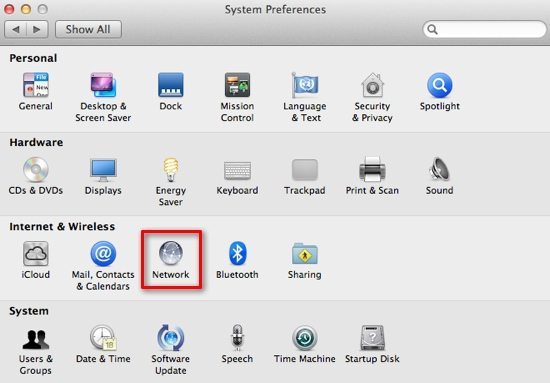
2. Click the Advanced button at the lower right to view more details about your network connection
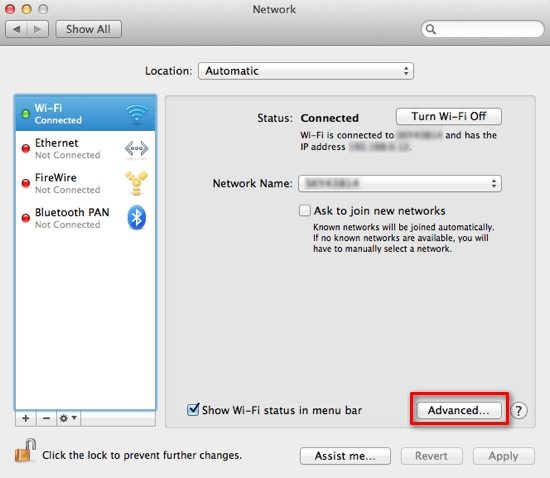
3. Under the TCP/IP tab, under most circumstances you’ll need the Configure IPv4 item set to Using DHCP. The reason is that in OS X Lion there have been some reports that manual configuration causes issues (though this may only be with early versions after the OS was first released)
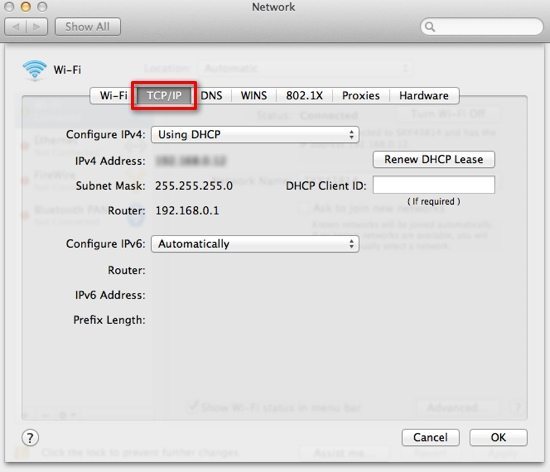
4. You should also look at the other network tabs such as Wi-Fi, and check that the network you want to join is shown in the list. Drag the networks into the desired order, for example you may as well move the network that you want to connect to right to the top of the list to make sure your Mac looks for that one first
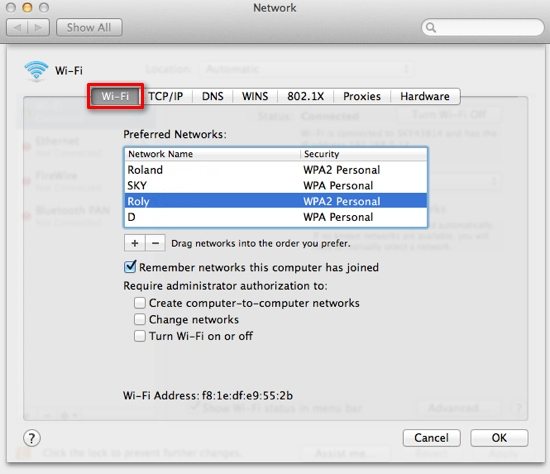
It’s also definitely worth just plugging in a network cable between your router and your Mac, to check whether basic Internet connectivity is working. If you can’t even connect to the Internet with a cable, then it points to a broader problem that may not be related to WiFi.
Remove and Re-Add The WiFi Service
One thing to try when you’re experiencing wireless network problems is to delete and then re-add the WiFi service.
Follow the steps below:
1. Open Network settings under System Preferences
2. In the left-hand side panel, select the Wi-Fi icon and then hit the Delete button (the small “–” icon) and confirm when prompted
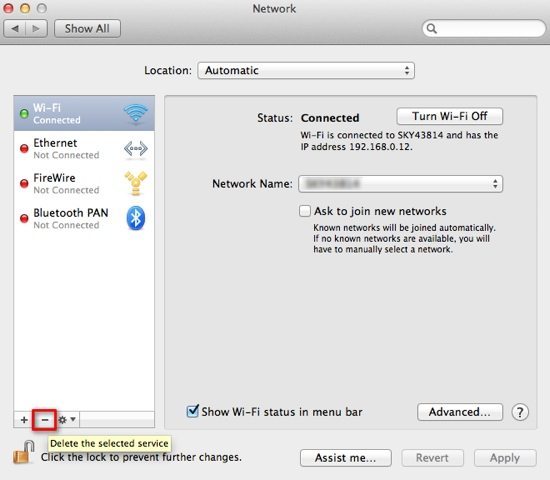
3. Once the WiFi service has been deleted, add a new one with the Add (“+“) button, and then enter the name of the new connection followed by Create. This establishes a new WiFi connection with the default settings. Just go through the various tabs to make sure WiFi is configured correctly (items such as the password) and try connecting to your wireless hotspot again. If prompted, re-enter any details that may have been lost when deleting the service
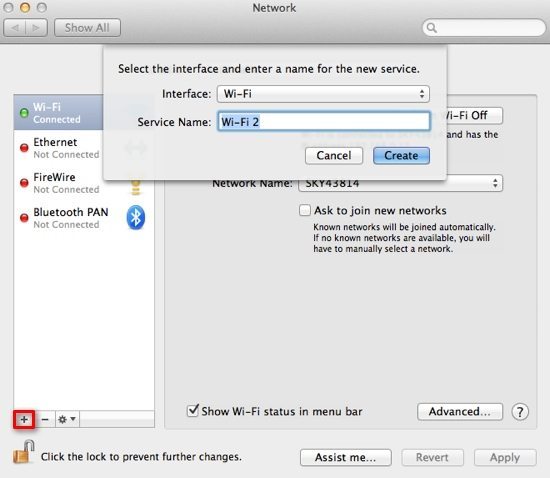
Check Your Wireless Router Settings
Your wireless router is normally provided by your Internet Service Provider (ISP) when you sign up to an Internet, phone or TV package. Sometimes however it’s necessary to reset the router (there should be a small reset button on the back), or even login to it and play around with the settings to use the optimal configuration. Unfortunately, quite often the administrator password isn’t provided to customers to stop them changing the default settings accidentally. If you know the password, it’s definitely worth logging in to the router to inspect the configuration.
To get to your router, open a new tab in Safari and enter the following address in the address bar:
http://192.168.0.1
This should take you to the router’s login / administration page where you need to enter its admin user name and login password. If this address doesn’t work, you can try one of the other default addresses commonly used by routers, such as 192.168.2.1 and 192.168.1.1
Make sure that you take a look at the security settings (such as the wireless key) and inspect the logs to see if there are any clues about potential issues. Every router is different, so there’s not one set of specific instructions that works across all models, but in general a few tweaks can usually help resolve your WiFi connection issues. For example, if there are dozens of WiFi hotspots in the area where you live, you might be subject to wireless interference issues if someone else has configured their router to use the same wireless channel – try changing it from the default channel to something different. You can also change the security settings (for example to use WPA or WPA2) or remove them completely, to see if that makes a difference.
Try Connecting Other Devices
It might seem pretty obvious, but you should always try connecting another device over WiFi to see if it’s actually your Mac or the wireless network itself which is experiencing technical issues. If you can successfully connect another computer, iPhone or tablet for example, then it points to an issue with your Mac rather than the network kit or Internet connection.
Also, you should of course try connecting your Mac to another wireless network to see whether the problem persists. If you can connect to another WiFi setup, then consider noting down the router’s configuration and setup details and comparing that to your own.
Reset PRAM and SMC
Your Mac’s Parameter RAM (PRAM) memory can occasionally be the cause of various technical issues, so if you have WiFi woes and nothing seems to work you could try to reset it. Follow the procedure below:
1. Shut down your computer
2. Locate the Command, Option, P and R keys. You’ll need to use these in a moment in step 4
3. Turn on the computer
4. Press and hold down the Command, Option, P and R keys before the grey screen appears
5. Hold down the keys until the computer restarts and you hear the startup sound for the second time
6. Release the keys
The PRAM should now be reset to the default values. Try connecting to the Internet by WiFi again when your computer has fully rebooted.
Another approach is to reset the main SMC chip (System Management Controller), which may resolve issues related to fans, lights, video and power. If you’ve tried everything else and you still can’t get your WiFi to work, you may as well reset the SMC, as there aren’t any negative consequences of doing so.
Here’s how:
1. Shut down the computer
2. Plug in the power adaptor
3. Press the Shift + Control + Option keys and the power button at the same time
4. Release all the keys and the power button simultaneously
5. Press the power button to turn on your Mac
Delete The Internet Preference Files
You can try deleting some of the Internet preference (.plist) files from your system Library folder. Sometimes, corrupted preference files can be responsible for things not working correctly. Follow these steps:
1. In Finder, press Command + Shift + G and in the drop-down dialogue box, enter ~/Library as shown below:
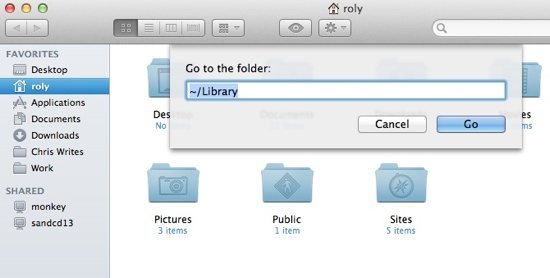
2. Locate the following preference files
- com.apple.internetconfig.plist
- com.apple.internetconfigpriv.plist
3. Copy the files somewhere (e.g. to your desktop) as a precaution and then delete them from the Library folder. Any similar files named com.apple.internetconfig[…] can also be safely deleted
4. Turn your Mac’s airport off and back on (just click the airport symbol in the menu bar and choose Turn Wi-fi Off)
Call a Professional!
Finally, if you’ve exhausted every possible avenue and still can’t resolve your WiFi connection issues, it might be time to concede defeat and take your Mac to the Apple Store to see if they can resolve the issue. Most problems with your Mac should be fixable by the technicians there, but there are of course lots of resources on the Internet that you can also use.





Try setting MTU to 1300 in Network.
Network -> Advanced -> Hardware -> Congifure: Manually, MTU Custom, 1300
That solved my WiFi problems
Thanks a lot for this post! I updated my mac a few days ago and have been having wifi problems since. I removed then re-added the wifi service, and it’s working great now.
Dude,you saved my life tonight.. I’m a developer and I have a lot of work to do for tomorrow and this fuckin wifi wasnt working…. thank you so much.. I want you to know that there is a man you saved his life anywhere in the world 🙂
Dude,you saved my life tonight.. I’m a developer and I have a lot of work to do for tomorrow and this fuckin wifi wasnt working…. thank you so much.. I want you to know that there is a man you saved his life anywhere in the world 🙂
Worked like a charm. Thanks!
Worked like a charm. Thanks!
I accidentally deleted my wifi and there is no wifi option on interface… HELP!
I accidentally deleted my wifi and there is no wifi option on interface… HELP!
Thanks a lot. I have tried every tips on the Internet nothing worked but yours.
Thanks, it seems that you have a very large knowledge on this subject. At my workplace everybody with pc can get on net, but we are 3 persons with mac who can’t. We can see the router on airport, but it seem that it would not aloud us to get to server. Any ideas?
Thanks, it seems that you have a very large knowledge on this subject. At my workplace everybody with pc can get on net, but we are 3 persons with mac who can’t. We can see the router on airport, but it seem that it would not aloud us to get to server. Any ideas?
Handy thanks! I’ve discovered (I hope) that the problem with my wifi especially on mac devices showing an exclamation ! mark and taking ages to connect (or sometime connecting then disconnecting after waking from sleep) was due to Connect mode select: Always-on Connect-on demand being set to Connect on demand instead of always on
Thank you! I spent about 4 hours reading about “possible” solutions but yours did the trick!
Thank you! I spent about 4 hours reading about “possible” solutions but yours did the trick!
Thanks for nothing Chriswrites. Very ambiugous instrucitons.
I rarely comment on articles, but I will here to warn you of a problem with your instructins.
Got to step 2 on the remove and re-add wifi. Removed wifi service, went to re-add, but your instructions are unclear, guessed that I was to add the name of my wifi service and now I have a status message that says my wifi service does not have an ip address and cannot connect to the internet. Nor can my mac find the network. Can’t get any further than this and as for “just go through the various tab settings to make sure wifi is configured correctly” just too too vague. Luckily i have clicked the revert button and undone these poor instructions. Please review these instructions for users of os Lion for mbp version 10.7.5. They are NOT helpful.
Please note that the .plist files are located in the Preferences folder of ~/Library
I have the same problem
When deleted the wifi could not connect it again saying no IP address for the wifi?
great !!! following yours tips -( e.g. delete the wifi and re add) it started working .dude your are the man…best ever !! saving my life…
Thank you Chris. I was trapped on an overnight layover in Narita Japan. Nearly six hours were spent googling and trying suggestions found with my iPhone. But it was your great advice to remove and re-add the WiFi service that got my laptop back on the Internet during the rest of my 19 hour layover.
I literally searched the internet for over an hour to figure out the problem with my mac. This website is the best! Thank you so much!!!!! You saved me time, money, and frustration!!! Thank you so much!!!
wow! thanks chris, i accidentally deleted the wifi service and have spent all afternoon a) trying to understand what i had done and b) finding the right search terms to bring up ideas about how to fix it. then your age came up at 6 pm!
Thanks, just upgraded to Mountain Lion (from Lion) and the Wifi dropouts started immediately. It wouldn’t hold a connection for more than 5 minutes. I did everything listed above and now the connection is solid – Over 5 hours so far with no dropouts. Thanks for posting this information.
fantastic! thanks..tried everything..yours works.
Thank you soooooo much! I’ve been trying to figure this out for days and was so fed up until I came across your suggestion and I tried resetting the PRAM and SMC and I finally have wifi again!
Thank YOU very much JOSE !!! I have been struggled this problem almost half a year :))
Great article. It’s 2015 and I couldn’t get internet! Deleting and re-adding wifi didn’t work for me. Eventually I got it to work by going into the router admin address http://192.168.1.254/ then going to advanced settings/ channel/ and change from automatic to a number between 1-11. I chose ‘3’. Somehow that worked. I was about to throw this mac out the window
This is an excellent article, covers everything you need to know in a simple, concise manner. Thank you!
Get yourself a wifi analyser app on your phone, look to see which channel is the least crowded, and set your wifi router to that channel. This is the only solution that worked for me.
Wow… Your advice and tips actually worked. Can’t thank you enough! Wish you could help me set up my idiot stick speakers now. If only!
Thanks! Setting TCP/IP to DHCP seems to have fixed my frustrating problem. Keep up the good work!
I got somewhat worries there. This solved it for me: reset the main SMC chip (System Management Controller)
Thanks 🙂
thank you guys big time, really helped with my senior manager whi was impatient.
My knowledge of computer is limited. After trying every suggestion by going down your list, I was finally able to get back on Safari by using PRAM and SMC reset. Thanks so much for help!